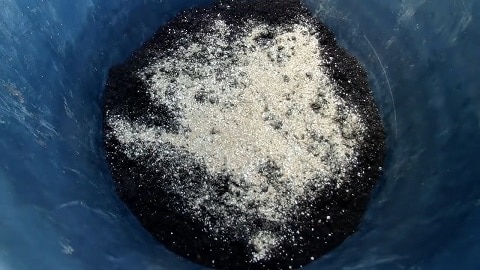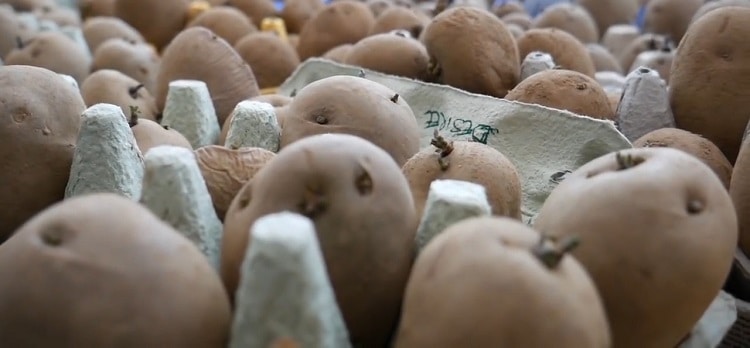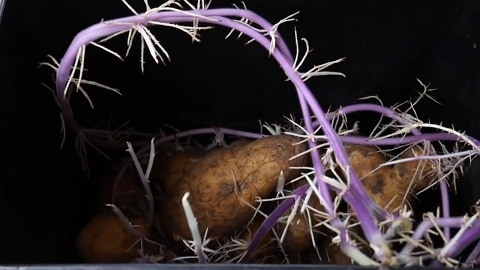Growing potatoes in containers is a great option for anyone with limited space Container gardening allows urban gardeners and those with small yards to easily grow potatoes in a small area.
In this complete guide, I’ll cover everything you need to know about successfully growing potatoes in containers including
When to Plant Potatoes
The best time to plant potatoes in containers is about 2-4 weeks before your expected last frost date This gives the plants time to sprout before warm weather arrives
If a late frost is predicted after planting, be sure to cover or move containers to a protected area. Potatoes can withstand light frosts but cold temps below 30°F can damage shoots and delay growth.
In warm climates, potatoes can be grown as a fall/winter crop. Check the maturity date for your variety and count backwards from your first expected fall frost.
Choose the Right Container
The container you use needs to be large enough to allow potatoes room to grow. As a rule of thumb, each potato plant needs at least 2.5 gallons of space. Standard 5-10 gallon containers are too small.
Look for containers that are at least 16-18 inches deep and 14-18 inches wide. I recommend 20-30 gallon containers for best results. Dark plastic buckets, trash cans, and potato grow bags all work well.
Make sure your container has drainage holes in the bottom to prevent soggy soil. Add some landscape fabric over holes to keep soil from washing out.
Selecting Seed Potatoes
Purchase certified disease-free seed potatoes from a garden center or online supplier. Avoid using potatoes from the grocery store, as they may be treated to inhibit sprouting.
Good container varieties include:
- Red Norland
- Yukon Gold
- Purple Majesty
- French Fingerling
- Rose Finn Apple
Choose smaller, early potato varieties over large russets. Compact types will produce better in containers.
How to Plant Potatoes in Containers
Step 1. Cut seed potatoes into chunks containing 1-2 eyes per piece. Let cut ends callous over for 1-2 days.
Step 2. Fill container about 1/3 full with potting soil mixed with compost or fertilizer.
Step 3. Place seed potato pieces cut-side down 4-6 inches apart, eyes facing up. Cover with 4 inches of soil.
Step 4. Water well until sprouts appear. Let soil dry out slightly between waterings.
Caring for Container Potatoes
Sunlight: Potatoes need at least 6-8 hours of direct sun daily.
Water: Check soil daily and water containers when the top 1-2 inches become dry. Avoid letting containers completely dry out.
Fertilizer: Apply a balanced liquid fertilizer every 2-3 weeks. Fish emulsion works well.
Hilling: When plants reach 6 inches, mound soil up against stems leaving just the top leaves exposed. Repeat hilling as plants grow.
How to Harvest Potatoes from Containers
New potatoes can be harvested early once plants bloom by gently digging in the container and removing a few small tubers.
For full sized potatoes, wait until vines completely die back and turn brown. Dig carefully through soil removing all tubers or dump container out onto a tarp for easy harvesting.
Cure potatoes 1-2 weeks in a dark, cool spot before storing. Brush off excess dirt but don’t wash until ready to use.
Troubleshooting Common Potato Container Problems
Poor Drainage
- Use container with adequate drainage holes
- Avoid overwatering
Nutrient Deficiencies
- Fertilize plants regularly
- Use rich organic potting mix
Pests & Diseases
- Keep an eye out for common potato pests
- Remove damaged foliage immediately
- Practice crop rotation
Tubers Exposed to Light
- Cover any exposed potatoes with soil
- Green potatoes are toxic – discard
Insufficient Watering
- Check soil frequently, water when dry 1-2 inches down
- Consistent moisture is key
Excessive Vine Growth
- Use short season, compact varieties
- Reduce nitrogen fertilization
Growing Potatoes in Containers – The Bottom Line
With the right container, soil, and care, it’s easy to get a productive potato harvest on a patio, balcony, or small yard. Focus on watering, fertilizing, and hilling your plants for the best results.
Potato container gardening does require more frequent attention than growing in the ground, but being able to easily grow potatoes in limited space makes it worth the extra effort.

Why use containers for growing potatoes?
I grow a lot of my potatoes in 30 litre buckets. They are fantastic and there’s a couple of reasons why. First is you get to control the growing environment. The soil can dry out, it can crack, potatoes get blown, all shapes and sizes. You may have a late frost, but with a container you can pick it up and take it to the polytunnel. Second, you can start them early if you want to. You can put them in the polytunnel and as soon as the plants start showing above the compost level, get them out into the sun, providing you’ve got good weather and is no frost forecast. Third, your crop will be there much quicker. You can actually speed up your harvest time because the black containers absorb less sun so it helps the plant to take up the nutrients much faster.
Use a really good compost, that is nice and light, with no massive pieces in it. This helps the roots to penetrate through easily. Put a good couple of inches of compost in the bottom of the bucket. The buckets I use are 30L and have got four big holes in the bottom, as well as holes right around the circumference are holes, which will aid in drainage.
When you grow potatoes in containers, you do not need to put any stones or anything down in the bottom of the container. The potatoes will send out roots through the bottom of the holes and it’ll work down into the ground. So if for any reason you forget to water, you get the best of both worlds.
Feeding when you grow potatoes in containers
You can add a bit of feed to the first couple of inches in the bottom of the container. About one and a half ounces in the bottom and mix it in. You could also add one and a half ounces of pelleted potato feed, it’s organic and the NPK on this is 6 .10 .10, so it’s really good for potatoes. This is going to encourage the tubers. When you’re looking at any potato feed you want to have nitrogen to start with, but not too much and then you need potassium in there, so get a good 10 and above for potassium.

Last year when I grew my potatoes in the chicken bedding, so had a massive amount of nitrogen – the tops were huge at about four feet tall of top growth, but not a lot of potatoes at all.
I chit the potatoes. but the reason I do is because I’m just itching to get growing something. You don’t see farmers growing chitted potatoes in tubs. Farmers just plant them without chitting first, but the soil is always warm before they plant their potatoes.

My seed potatoes have really long white shoots, what do I do?
The only way to deal with that is to snap them off and re-chit the potatoes. Last weekend I found some potatoes that I’d had in my kitchen and I had forgotten about. They were in a dark container and they were in the warm. All the conditions that you don’t want for chitting your potatoes. They have got about 1 foot long stems on them because they were desperately seeking light.

The potato is looking for light, so when you’re chitting them you have to keep them in a really bright place and it’s got to be cold, but frost free. They should have very small green growth and that’s what you’re looking for.
How to Grow: Potatoes in Pots / Homegrown Garden
FAQ
How many potatoes can you grow in a container?
In general, one potato plant will need about 2.5 gallons of grow space, so if you want to keep potatoes in 10 gallon pots, you can usually fit about 4 potato plants per pot. Containers that are between 2 and 3 feet deep are ideal. Fabric potato grow bags are a popular choice.
How many potato plants can you plant in a 5-gallon bucket?
Never use buckets that previously housed chemicals, paint, or other unsavory or unknown materials near edible plants. Instead, use buckets made of food-safe plastic and clean them out thoroughly before planting. Standard 5-gallon buckets can hold about 2 potato plants, while 10-gallon buckets can hold 4 potato plants.
What month do you plant potatoes?
- Timing: Aim to plant potatoes about 2-4 weeks before the average last frost date, which is typically in late March or early April for Los Angeles.
- Soil Temperature: Ensure the soil temperature is at least 45-55°F (7-13°C) for optimal growth.
- Seed Potatoes: Use certified disease-free seed potatoes from a reputable source.
- Planting Depth: Plant seed potatoes 3-4 inches deep and 9-12 inches apart.
- Sunlight: Potatoes need at least 6-8 hours of sunlight per day.
- Soil: Potatoes prefer well-drained, loose soil.
- Harvest: You can expect to harvest potatoes in late summer or early fall, depending on the variety.
Should I water potatoes every day?
- Water Needs Vary: Potatoes need consistent moisture, especially after planting and during tuber formation, but they are sensitive to both overwatering and underwatering.
- Watering Frequency: Generally, potatoes need about 1 to 2 inches of water or rainfall per week.
- Soil Moisture: Check the soil moisture by sticking your finger in the soil; if it feels dry, water.
- Signs of Overwatering: Yellowing leaves and wilting can indicate overwatering, while wilting with leaves drooping suggests underwatering.
- Signs of Underwatering: Wilting and dry soil signal under-watering, affecting yield and tuber quality.
- Adjust Watering: Adjust watering based on growth stages and soil moisture levels.
- Watering Technique: Water thoroughly when you do water, ensuring the water soaks into the soil.
- Soil Type: Potatoes require well-drained, fertile, sandy loam to silt-loam soils.
- Watering During Peak Heat: During extreme heat, potatoes may need more water, potentially every 2-3 days.
- Stop Watering: Stop watering when the foliage begins to turn yellow and die off.
Can you grow potatoes in a garbage can?
Potatoes can be grown in a potato tower, garbage can, Tupperware bin, or even a gunnysack or burlap bag. The process is simple and something the entire family can enjoy from planting to harvesting. The best potatoes to use for container gardening are those that mature early. Choose certified seed potatoes, which are disease-free.
How do you grow potatoes in containers?
The first step to growing potatoes in containers successfully is using the correct type of pot. Look for a container at least 16 inches wide and 2 feet tall or any container that can hold at least 3 gallons of soil. This could be a plastic or terracotta pot, an old dustbin, a bucket, or a grow bag.
What size container should a potato grow in?
When choosing a container to grow your potatoes in, select one that has a capacity of 10 to 15 gallons and is 2 to 3 feet deep. If potato plants are grown too close together, they can compete for resources and it will ultimately affect growth and yield.
Can you plant seed potatoes in a container?
When you plant seed potatoes in a container, you don’t have to wait for them to sprout before planting them. Sprouts from seed potatoes will start emerging after two weeks until about 28 days. Buy some good quality garden soil for container gardening. It should be a well-draining soil mixture. There are many on the market that include compost.
How do I choose a suitable container for potato cultivation?
When searching for suitable containers for potato cultivation, keep these pointers in mind: Size Matters: Potatoes need room to flourish. Aim for containers that are at least 2-3 feet deep and can hold 10-15 gallons of soil. This ensures enough space for the roots and tubers to develop.
Can you grow potatoes in a plastic container?
Use high-quality potting soil that is fast-draining, especially if you’re using a plastic container. A good option is a half-and-half mixture of commercial potting soil and quality compost. Don’t use ordinary garden soil for growing potatoes in containers; it drains poorly and contains pathogens and weed seeds.
